Having purchased engines
from Lea-Francis for chassis 003, 004, 005, and
006 in both 1500 cc and 2.0 litre forms, Turner
designed and manufacture his own alloy cylinder
heads featuring dual spark plugs. Having
achieved reasonable race success with these
engines and seeing the potential for further
weight losses, Turner persuaded Lea-Francis to
produce a series of aluminium alloy cylinder
blocks. It is thought that twelve such cylinder
blocks were produced. The cylinder blocks are
identified by the initials 'LFT' as casting
marks.
|
It is known that Turner
built at least three all alloy LFT engines, and
it is believed that at least twelve of the LFT
cylinder blocks were sold to Connaught
Engineering to form the basis for their Formula
2 engine.
Engine No.1.
A 1.5 litre version fuelled by twin SU
carburettors
This engine was sold to
George Nixon (formally owner of the ALTA, race
prepared by Turner) who installed the engine
into a Lotus Mk.8 sports racing car.
|
|
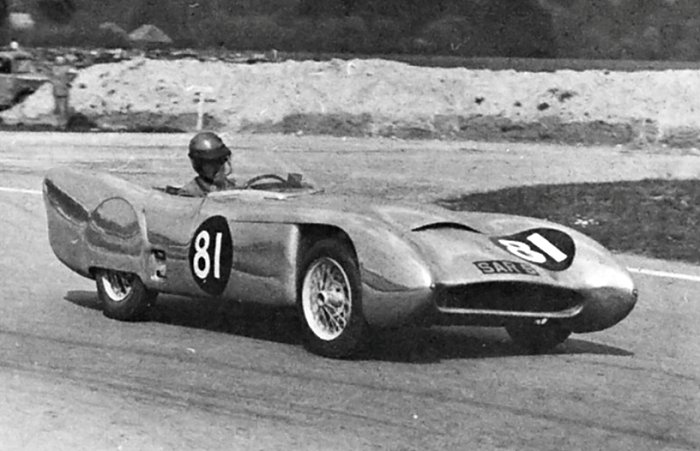
Colin Chapman driving a Lotus
Mk.8 similar to the one being sold by Nixon. |
 |
An advert from
Autosport magazine, 7th October, 1955. |
|
Engine No. 2
The 2.0 litre version fuelled by
an SU Mechanical fuel injection system for the 1953
Turner F2 single-seat race car. This engine was the
personal property of John Webb. |
|
Engine No. 3
In May 1955 Kieft
installed a 1500 cc Turner LF engine into one of its
sports cars for Welsh club racer Berwyn Baxter. The
car ran in several club races before it was entered
for the Paris 24 Hour Race at Montlhery where
unfortunately it retired. After replacing the SU
fuel injection system with special SU carburettors,
the car ran in the Le Mans 24 Hour race, but
disappointingly retired on its sixth lap due to
cooling problems. |
|
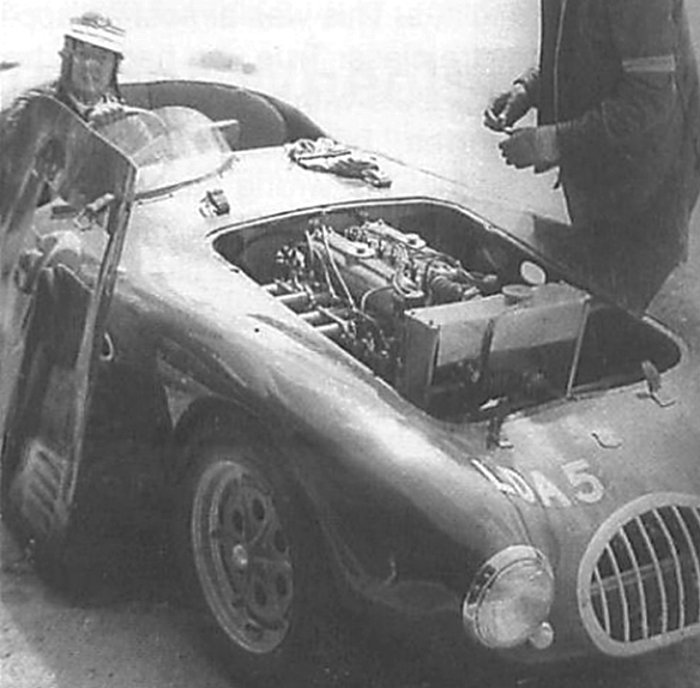
The 1.5 litre version fitted
into a Kieft sports racing car, fitted with SU
mechanical petrol injection. |
The following comments were
made to the Turner Register following tributes
to Jack Turner on his death:
|
May I add a little
concerning Jack Turner, certainly a highly
skilled engineer, innovative thinker and an
engaging character. He had a persuasive manner
with the propensity to avail upon others to work
for little or no reward. He did not design the
aluminium cylinder block for the Lea-Francis
engine but persuaded our engineers to undertake
the project. The drawings are still in our
possession. He did, however, design his own
cylinder head with valves too large with twin
plugs per cylinder; this was not a success! The
500 cc 4-cylinder engine was certainly Jack's
idea but he persuaded our late Technical
Director, Hugh Rose to undertake all the
drawings, which were done at Hugh's home in
Wolverhampton. Free of charge of course!
Signed by A. B. Price,
Managing Director, Lea-Francis Cars Limited. |
|
The Turner
500 cc Engine
Having experienced 500 cc
racing with his involvement with the Bardon-Turner
racing car, Jack Turner embarked on the design
and development of his own small, light and high
revving alternative to the JAP, Norton and
Matchless engines which dominated the 500 cc
scene at the time.
The engine consisted of a water-cooled twin
overhead camshaft cylinder head mounted on four
individual air-cooled cylinder barrels. The roller
bearing crankshaft with dry-sump lubrication, was
carried in a separate crankcase. |
| Seeing its potential, Kieft offered the Turner
500 as an engine alternative for its Formula 3
racing car. Three engines were built, two were to be
fitted in the Kiefts of Jim Burgoyne and Wally Ford,
whilst Jack Turner retained the third. In effect
some parts were cannibalised to keep the Burgoyne
engine running. |
|
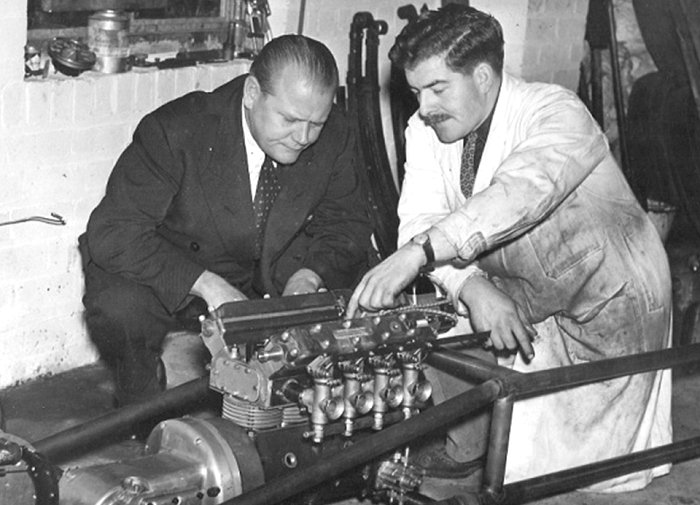
Jack Turner is seen discussing
the engine with Cyril Kieft. |
|
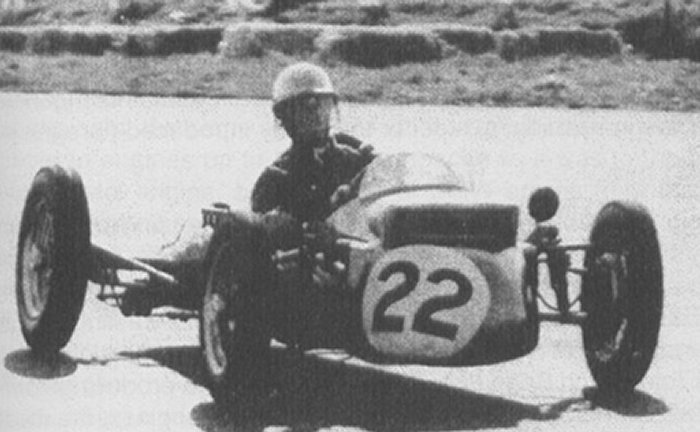
Jim Burgoyne racing his Turner
powered Kieft F3 during the 1953 season. |
|
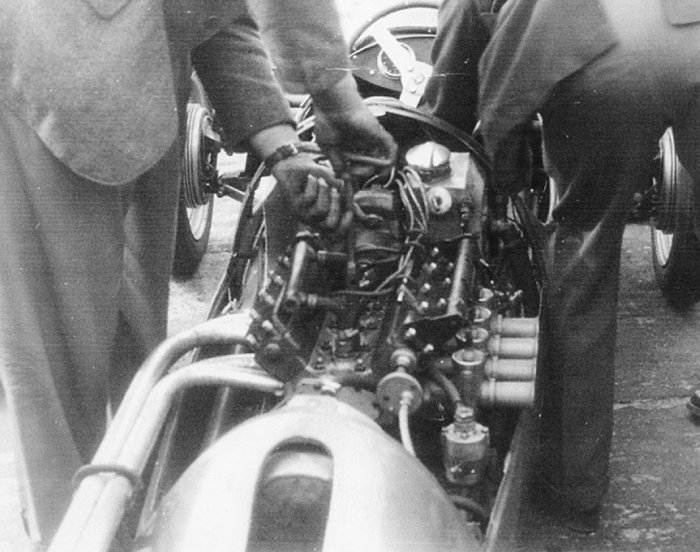
Turner 500 installed in
the Burgoyne Kieft. |
|
Disappointingly in competition,
due to an inappropriate choice of gear ratios, the
Turner 500 engine did not fulfil its full potential,
falling short of the power and torque outputs
developed by the JAP and Norton engines favoured at
the time.
The Turner
Formula 2 Race Car Chassis No. 007
In 1952 John Webb, now a
Director of the newly formed company Turner Sports
Cars (Wolverhampton) Limited, commissioned and
financed the building of a racing car to comply with
the FIA Formula 2 regulations at the time. Webb
continued to drive the Turner MG Formula Libre race
car during 1952 while the Formula 2 car was built
ready for the 1953 race season.
John Webb's initial drawings
for an F2 car: |
| The car was built on the shorter 7ft 6in.
wheelbase chassis with 11inch Girling brakes and
Turner Magnesium wheels. The engine was an
all-aluminium version of the Lea-Francis Turner 2
1itre unit and was fuelled by an SU Mechanical
petrol injection system. Power was transmitted
through an Armstrong Siddeley pre-selector gearbox
and a chassis mounted ENV differential. |
|
Known race
entries:
1953
18th April. West Hants & Dorset
Car Club Event at Ibsley, Hampshire. Driver: J.
Webb. Entered for 15 Lap Race for cars over 500 cc
and 7 Lap Handicap Race.
7th May. Silverstone
International Trophy Meeting. J. Webb finished 16th
and last in the 15-lap heat. In the 35-lap final he
finished 19th out of 21 finishers. |
|
25th May. Crystal Palace
International Car Race Meeting. J. Webb finished 9th
in a field of 16 in the race for non-supercharged
cars over 500 cc and up to 2 litres.
25th July. Snetterton
Internation Meeting. Driver: Jack Fairman. U.SAF.
Trophy Race. Retired after two laps when the engine
stopped after the ignition was inadvertently
switched off.
3rd August. Thruxton. Driver:
J. Webb. No record of results.
15th August. Charterhall,
Scotland. Driver: Jack Fairman. Retired due to
engine mechanical failure. |
|
19th September. Crystal
Palace. Driver: J. Webb. Race ran in two heats.
Finished heat 1, not known if he finished in
heat 2.
26th October. Goodwood
International Meeting. Madgwick Cup 7-lap race.
J. Webb Woodcote Cup race. J. Fairman Did Not Finish. |
|
1954
19th April. Goodwood.
Driver: J. Webb. Retired after only one lap.
15th May. Silverstone
International Trophy Driver; Jack Fairman.
Finished 13th in a strong international field.
30th May. Aintree 200.
Driver: Jack Fairman. Feature race for Formula
Libre cars. Fairman finished 9th in the first
17-lap heat and lined up on the 4th row of the
starting grid in a field of 20 starters, but as
yet there is no record of where he finished.
7th June. Goodwood. Driver:
J. Webb. Finished 5th in a 5-lap race.
15th June. Silverstone
International Trophy. Driver: J. Webb. Result
not known.
2nd August. Crystal Palace.
Driver: Driver: J. Webb. August Trophy Final,
5th. Glade Trophy Race 5th.
17th August. Oulton Park
Gold Cup Meeting. Driver: Jack Fairman. As
Fairman came out for the Formula 1 race a
half-shaft broke, posting him as a non-starter.
24th August. Snetterton.
Driver: Jack Fairman. Retired with mechanical
failure on lap 13 of a 40 lap race.
31st August. Castle Combe.
Driver: Jack Fairman. Retired with 'smoke'
emitting from the engine bay.
25th September. Goodwood.
BARC International Meeting. Driver: Jack Fairman.
Madgwick Cup Race. Problems in practice leading
to Did Not Start.
1955
11th April. Goodwood.
Driver: Ron Flockhart. 7-lap race for old 2
litre F2 cars. Retired after 4 laps. F1 Race:
Did Not Start. |
| 30th May, Crystal Palace, Whit Monday.
Driver: John Webb. Overturned at Ramp bend when
the brakes locked on. Webb was unhurt and able
to walk away. |
|
30th July. Crystal Palace. Driver: J. Webb. Failed
to qualify for the final of the London Trophy. Finished 3rd in Formula Libre Consolation Race.
13th August. Snetterton. Driver: J. Webb. In what
was to be Webb's last race, ended in another disappointment with another
retirement. |
| During 1955 John Webb became engaged to be married,
and although his fiancée had supported him in his motor racing, John
decided the time had come to call an end to his racing activities to
concentrate on the family business and his forthcoming marriage. After
its final race at Snetterton, the car and its race tender were
advertised for sale in Autosport magazine during September 1955.
Following the end of the F2 race program in 1955, Turner decided to
build a production run of small two-seater open sports cars powered by
the Austin A30 engine. |
| In 1956 the company moved from Merridale Street to
former RAF premises at Pendeford Airport, Wolverhampton. |
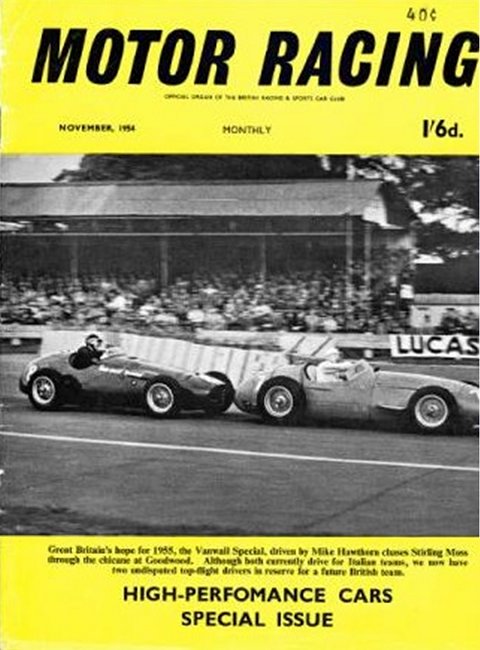 |
Turner engines were
featured and described in Motor Racing magazine,
November, 1954. |
|
Rewritten and amended by Ken Robbins, 2018
References and Sources
A Record of Grand Prix and Voiturette Racing, Volumes 5 and 6, by Paul
Sheldon and Duncan Rabagliati
MG K3 Dossier by M. H. Hawke.
Turner Sports Cars by Peter Tutthill.
Kieft Racing Cars by Peter Tutthill.
Powered Vehicles of the Black Country by Jim
Boulton.
Grand Prix Cars 1945 to 1965 by Doug Nye.
Motor Racing Magazine, November, 1954.
Jack Turner's Personal Photo Collection.
Turner Sports Car Register Archives and Website. |
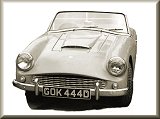 |
|
 |
Return to
Part Two |
|
Return to
the beginning |
|